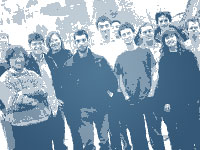Kan Seminars
The Kan seminar is an intensive second year graduate course that has for decades formed the foundation of the graduate algebraic topology program at MIT. It was begun, not surprisingly, by Dan Kan, and run for many years by Haynes Miller and Mike Hopkins, and more recently by Mark Behrens.
I thought the Kan seminar was such an effective pedagogical format that it ought to be exported. In 2007, I started a Kan seminar at Stanford, known as Classics in Geometry and Topology, which has run ever since, and in the fall of 2011 started a Kan seminar at Oxford, entitled Classics in Algebraic Topology. Below is some more information about theses seminars.
—-
The “Kan seminar” aims to give students a solid understanding of modern algebraic topology by having them read important original papers in the field. On the one hand, all standard courses in algebraic topology teach students the foundations of the discipline, covering roughly the subject as developed from 1930 to 1960. On the other hand, Topics classes typically treat a specialized subject of recent interest and thereby focus on material from 1990 to the present. This leaves an enormous gap in the students’ knowledge and leaves them unexposed to most of the achievements and techniques of modern topology. Even a conscientious student studying hard for a broad and thorough Qualifying Exam will have trouble properly filling this gap.
The seminar is therefore designed to give students a thorough look at the algebraic topology literature from roughly 1960 to 1990. Students read the classic, ground-breaking papers from this period, which gives them a historical understanding of the discipline, a knowledge of the central results of the field, and an exposure to a range of important techniques. It gives students what is for many their first direct exposure to the original literature, training both their research skills and giving them a sense of the actual development of significant mathematics—a far cry from the packaged textbook treatment they will have seen in a first-year course.
For example, in the course of the seminar, the students would read, among various others, the papers:
-
Serre, Homologie singuliere des espaces fibres
Serre, Cohomologie modulo 2 des complexes d’Eilenberg-MacLane
Thom, Quelques proprietes globales des varietes differentiables
Milnor, On manifolds homeomorphic to the 7-sphere
Milnor, The Steenrod algebra and its dual
Adams, On the non-existence of elements of Hopf invariant one
Kervaire, A manifold which does not admit any differentiable structure
Kervaire and Milnor, Groups of homotopy spheres
Wall, Finiteness conditions for CW-complexes
Adams, On the groups J(X) — IV
Adams and Atiyah, K-theory and the Hopf invariant
Quillen, Homotopical algebra
Segal, Classifying spaces and spectral sequences
Quillen, Higher algebraic K-theory I
Nishida, The nilpotency of elements of the stable homotopy groups of spheres
Adams, Stable homotopy and generalised homology
Milnor and Stasheff, Characteristic Classes
Becker and Gottlieb, The transfer map and fiber bundles
Goresky and MacPherson, Intersection homology theory
Waldhausen, Algebraic K-theory of spaces
Hopkins and Smith, Nilpotence and stable homotopy theory II
One important feature of the seminar is that it primary consists of students giving hour-long talks about the individual papers they have read. This is a key pedagogical aspect of the seminar, as it trains the students to give well organized, carefully crafted, well delivered, clear and cogent mathematical talks, a skill that will serve them well later on. Indeed, besides being a mathematical guide, one of the primary roles of the teacher of the seminar is to shepherd students through the process of preparing and giving excellent mathematical lectures, and to give students constructive feedback on the lectures that will help them improve their future talks.
During the course, each student will lecture on three or four papers. These papers are chosen by the student in consultation with the professor, and as such can be tailored to the individual student’s interests and can be chosen to form a coherent sequence. In particular, according to student interest, the papers covered can and will range more widely than those listed above. The students also read every paper that is being presented in the seminar, and write short comments reacting to or commenting on each paper (excepting those papers on which they personally lecture).
—-
